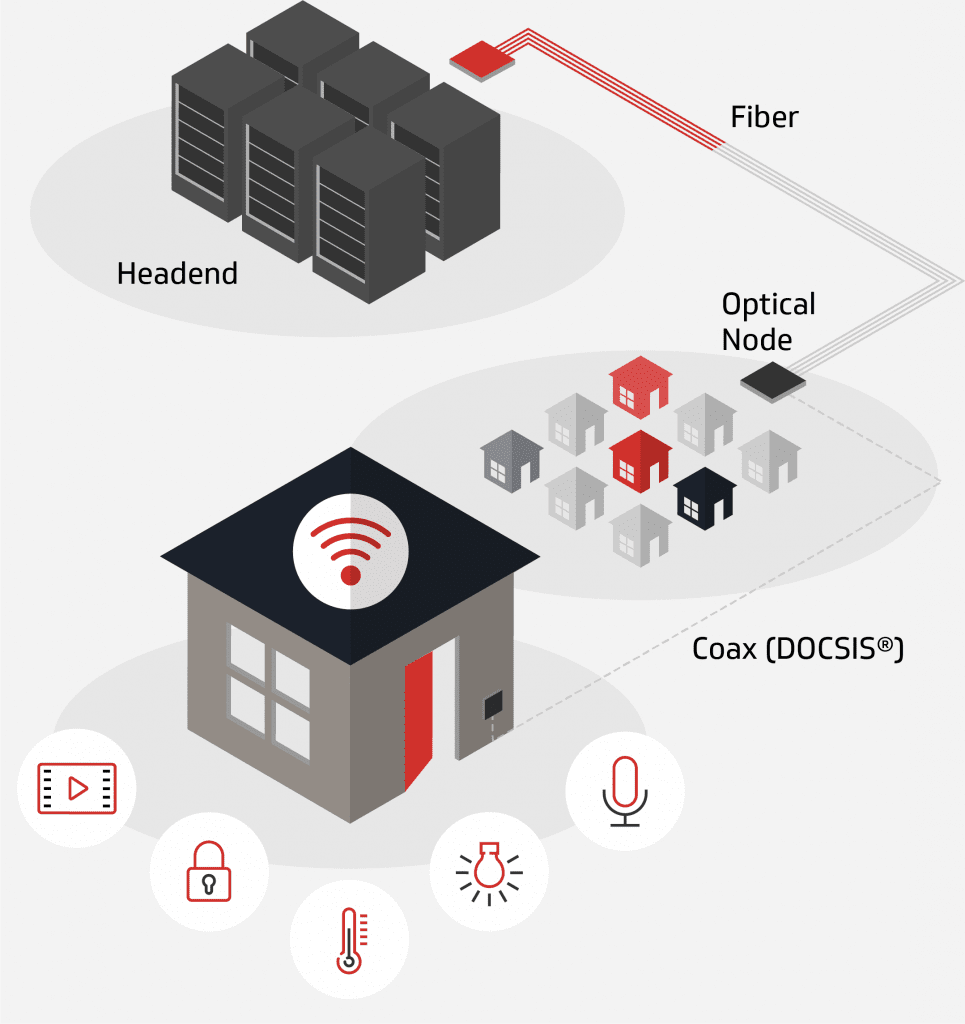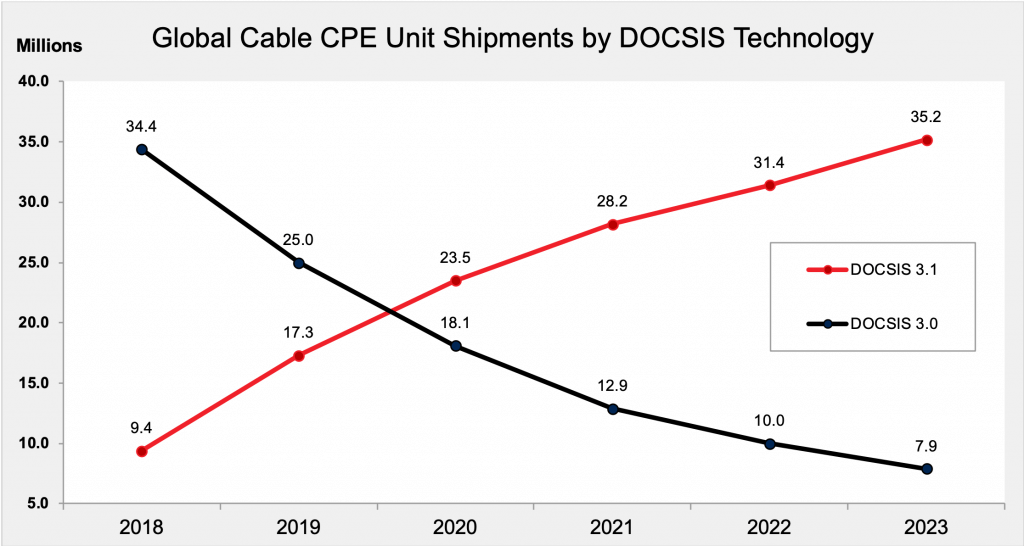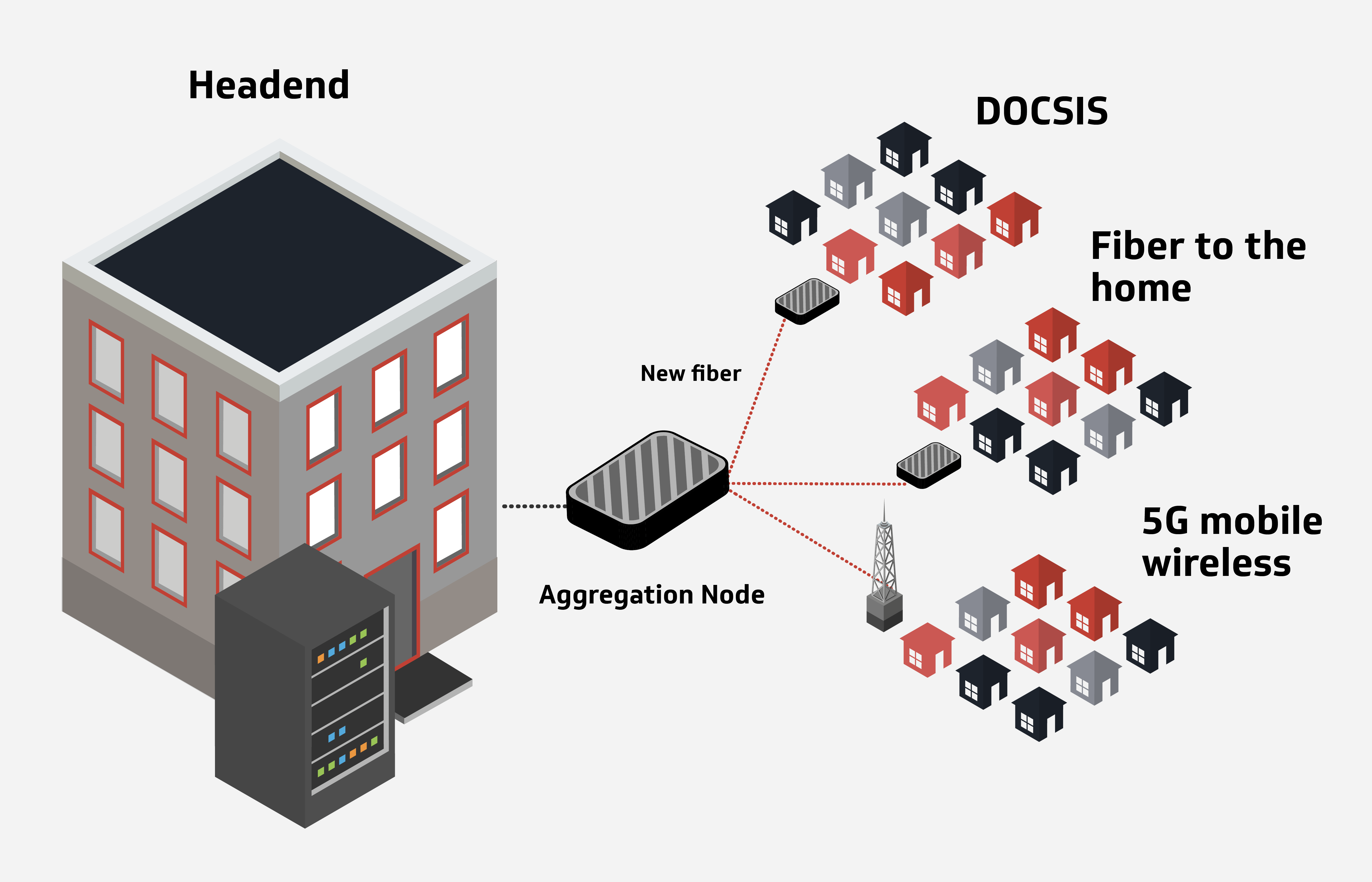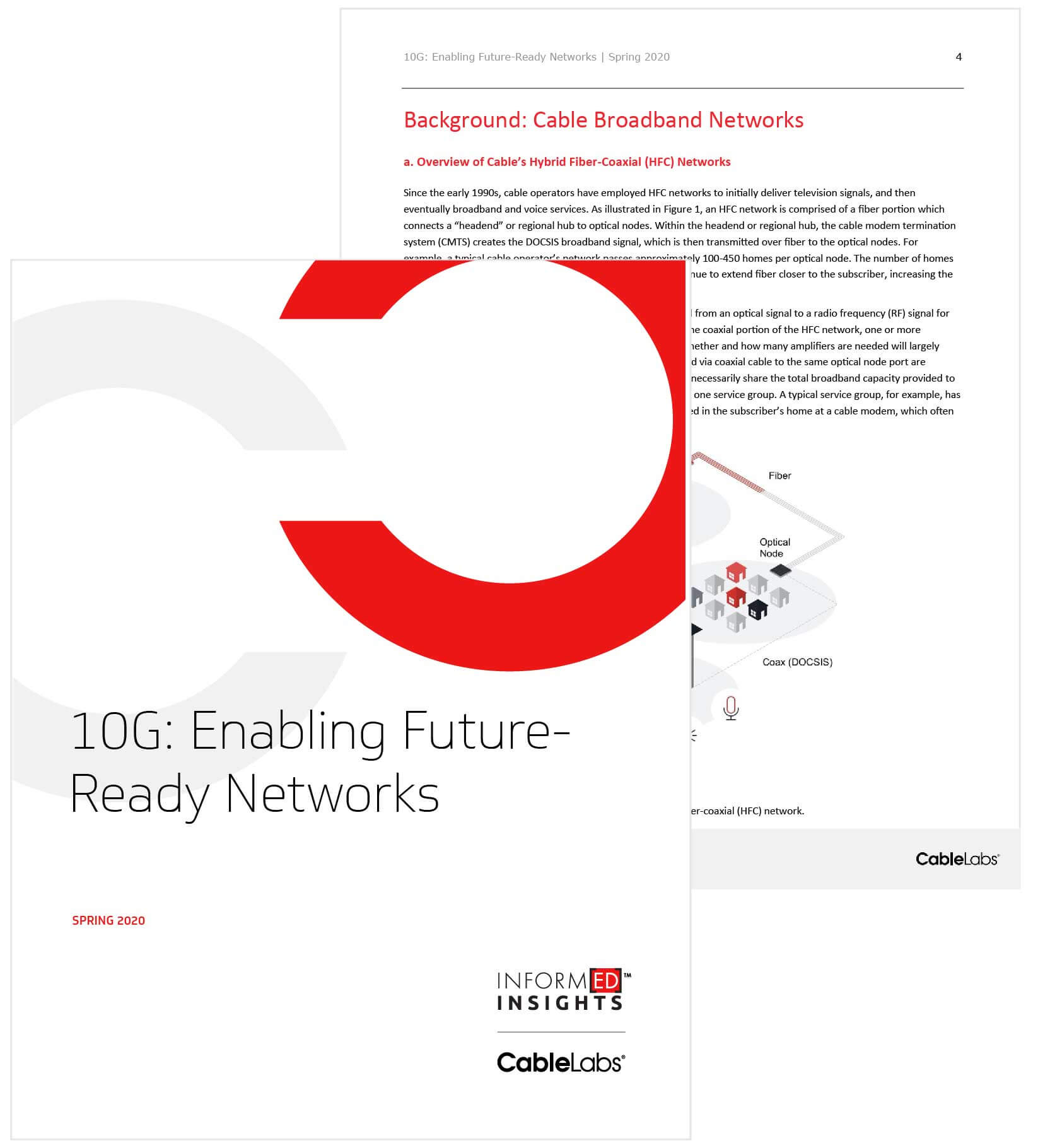SPRING 2020
10G: Enabling Future-Ready Networks
As technology becomes more crucial to our lives, we need a robust network to support the new hyper-connected, multi-gigabit reality of the near future. We require a network that’s faster, simpler, more reliable and more secure than anything we’ve seen so far—a network we call 10G.
Executive Summary
The 10G platform is a combination of technologies that will deliver symmetric multi-gigabit Internet speeds with a vision toward enabling symmetric 10 gigabits per second (Gbps) services.[1] 10G will be 100x faster than what most consumers currently experience, and will offer lower latencies, enhanced security, and greater reliability. While 10G is the next great leap for broadband, the technologies that enable it are already in development. The global cable industry has been anticipating consumer demand for better network performance for years and has invested significant effort into laying the groundwork for 10G. Most recently, these investments were evident in the ability of cable networks to accommodate the rapid increase in demand associated with the societal impacts of COVID-19, with little to no impairment of cable broadband services.[2] Today's cable networks will continue to scale to 10G performance, increasing speed and capacity, as these new technologies make their way to the network.
10G is a continuation of the cable industry's long history of regularly increasing the performance of their hybrid fiber-coaxial (HFC) broadband networks to stay well ahead of consumer demand. CableLabs' initial Data Over Cable Service Interface Specification (DOCSIS®) standard — the technology that enables broadband service over HFC networks — was released in 1997, and CableLabs and the broader cable industry have continued to regularly and significantly increase the performance capabilities of DOCSIS technology. With the most recent version of the specification — DOCSIS 4.0, HFC networks will readily be able to support 10 Gbps of downstream capacity and 6 Gbps of upstream capacity, enabling the delivery multi-gigabit services to consumers. CableLabs advances in coaxial, optical, and wireless technologies are enabling the cable industry to move towards the 10G vision of symmetric 10 Gbps speeds, access network latency of 1 millisecond (ms), and enhanced security and reliability — ensuring HFC networks are future ready, capable of delivering the broadband services consumer demand today and well into the future.
The industry's commitment to innovation, coupled with a massive network footprint, positions cable to deliver the myriad of new online experiences that will enable connected economies and societies. To make 10G a reality, an investment-friendly economic and policy climate must foster continued risk-based capital investment. This combination of innovation and investment has historically yielded transformational technological advances, and with 10G, the cable industry is doing its part to help chart the way we live, work, learn, and play in our digital future.
Background: Cable Broadband Networks
Overview of Cable's Hybrid Fiber-Coaxial (HFC) Networks
Since the early 1990s, cable operators have employed HFC networks to initially deliver television signals, and then eventually broadband and voice services. As illustrated in Figure 1, an HFC network is comprised of a fiber portion which connects a "headend" or regional hub to optical nodes. Within the headend or regional hub, the cable modem termination system (CMTS) creates the DOCSIS broadband signal, which is then transmitted over fiber to the optical nodes. For example, a typical cable operator's network passes approximately 100-450 homes per optical node. The number of homes passed per node continues to decrease as cable operators continue to extend fiber closer to the subscriber, increasing the overall capacity available to each subscriber.
In the optical node, the DOCSIS broadband signal is transformed from an optical signal to a radio frequency (RF) signal for transmission over the coaxial network to subscriber homes. In the coaxial portion of the HFC network, one or more amplifiers may be used to extend the reach of the RF signal — whether and how many amplifiers are needed will largely depend on the length of the coaxial cable. Subscribers connected via coaxial cable to the same optical node port are typically referred to as a "service group," and those subscribers necessarily share the total broadband capacity provided to that coaxial segment. Each optical node may support more than one service group. A typical service group, for example, has between 50 and 200 subscribers. The RF signal is then terminated in the subscriber's home at a cable modem, which often includes an integrated Wi-Fi access point.
 Figure 1. The cable hybrid fiber-coaxial (HFC) network.
Figure 1. The cable hybrid fiber-coaxial (HFC) network.
DOCSIS Evolution: A Track Record of Increasing Performance
Since 1997 and the launch of the original DOCSIS specification, the cable industry has steadily increased the capabilities of the DOCSIS technology. As summarized in Table 1, DOCSIS technology has realized major advances with each iteration. Today, the cable industry has widely deployed the latest commercially available, cable broadband technology, known as DOCSIS 3.1. The DOCSIS 3.1 specification includes optional features that can support up to 10 Gbps of downstream capacity and currently available DOCSIS 3.1 equipment can support 5 Gbps of downstream capacity, readily enabling consumer gigabit service offerings. Moreover, the specification for the next generation of technology — DOCSIS 4.0 — was released in 2019 and will support symmetric multi-gigabit services. In just over 20 years, DOCSIS capacity has increased 250x in the downstream and 600x in the upstream, putting cable technology well down the path to achieving the vision of 10G. These advances and more will help enable emerging applications such as autonomous vehicles, immersive telework and telehealth, and redesigned education.
Table 1: The Evolution of DOCSIS Technology.[3]
| DOCSIS 1.0 | DOCSIS 1.1 | DOCSIS 2.0 | DOCSIS 3.0 | DOCSIS 3.1 | DOCSIS 4.0 | |
|---|---|---|---|---|---|---|
| HIGHLIGHTS | Initial cable broadband technology, high-speed internet access | Added voice over IP service, gaming, streaming | Higher upstream speed, capacity for symmetric services | Greatly enhances capacity, channel bonding, IPv6 | Capacity and efficiency progression, OFDM, wideband channel | Symmetrical streaming and increased upload speeds |
| MAX DOWNSTREAM CAPACITY | 40 Mbps | 40 Mbps | 40 Mbps | 1 Gbps | 10 Gbps | 10 Gbps |
| MAX UPSTREAM CAPACITY | 10 Mbps | 10 Mbps | 30 Mbps | 100 Mbps | 1-2 Gbps | 6 Gbps |
| INITIAL SPECIFICATION DATE | 1997 | 1999 | 2001 | 2006 | 2013 | 2019 |
Most importantly, these advances in DOCSIS technology have and will continue to translate into meaningful increases in the performance of cable broadband services available to consumers.[4] As illustrated in Figure 2 below, global shipments of DOCSIS 3.1 consumer premise equipment now exceed that of DOCSIS 3.0 equipment and that shift will further accelerate in the next few years. In the United States, cable operators have effectively completed the conversion of their networks to DOCSIS 3.1 technology and gigabit service is almost universally available across the cable footprint.[5] In Europe, we are seeing a similar trend — cable operators rapidly converting to DOCSIS 3.1 technology.[6] The deployment of DOCSIS 3.1 is significant and foundational to lay the groundwork for the eventual deployment of DOCSIS 4.0 technology — enabling symmetric multi-gigabit services — and a further step toward realizing the full 10G vision.
 Figure 2: Global Cable CPE Unit Shipments by DOCSIS Technology.[7]
Figure 2: Global Cable CPE Unit Shipments by DOCSIS Technology.[7]Technologies: The Road to 10G
A suite of cable technologies will enable the enhanced features of the 10G network, including its speed, latency, security and reliability.
Faster Internet Speeds
Many factors feed the need for ever-faster Internet speeds: The network requirements of new online application innovations, the ongoing growth of bandwidth demand by users, and the need to supply dense user environments such as businesses, public venues, and city centers all point toward the need for the continued growth of broadband capacity. Immersive experiences like interactive holographic projections, video walls, next-generation artificial intelligence (AI) and virtual reality (VR) tools will all require a super high-capacity network that can deliver an immense amount of data to end-users. The following 10G technologies will enable cable gigabit and multi-gigabit speeds, in both downstream and upstream, over cable hybrid fiber coax (HFC) networks. To fully enable these new network technologies, cable operators will continue to deploy fiber deeper into HFC networks and migrate to Distributed Access Architectures.
DOCSIS® 3.1 Technology
The DOCSIS 3.1 specification is the current industry standard for providing high-quality Internet access over HFC networks.[8] DOCSIS 3.1 provides increased capacity and other performance enhancements in comparison to the prior version — DOCSIS 3.0. These performance enhancements were enabled through key advancements, most notably, (1) increased spectral efficiency including the adoption of orthogonal frequency division multiplexing (OFDM) and more sophisticated forward error correction and (2) additional spectrum for broadband data transmission — up to 1.2 GHz. The DOCSIS 3.1 specification includes optional features that could enable capacities of up to 10 Gbps downstream and up to 2 Gbps upstream, and today, commercially available DOCSIS 3.1 modems and gateways have a downstream capacity of 5 Gbps and an upstream capacity of 1.5 Gbps.[9]
DOCSIS® 4.0 Technology
Initially released in 2019 and updated earlier this year, the DOCSIS 4.0 specifications incorporate two new, significant requirements into the technology.[10] The first is full duplex operation, and the second is downstream operation up to 1.8 GHz. With these additional requirements, DOCSIS 4.0 equipment will support 10 Gbps of downstream capacity and 6 Gbps of upstream capacity.[11] The significant increase in upstream capacity will readily enable the offering of symmetric multi-gigabit services over HFC networks. We anticipate the widespread availability of these symmetric multi-gigabit services will usher in whole new categories of applications, such as fully immersive experiences.[12] The expanded upstream capacity is made possible by incorporating emerging techniques from wireless networks — full duplex communication, which enables upstream and downstream transmissions to efficiently use the same spectrum at the same time. In addition, the complete specification of downstream operation using frequencies up to 1.8 GHz will significantly extend DOCSIS downstream capacities beyond those currently available. Taken together, these advancements are a major step toward making 10G a reality.
Fiber Deep and Distributed Access Architecture (DAA)
The deployment of fiber deeper into the cable network and the migration to a Distributed Access Architecture are key enablers to the 10G vision and provide cable operators with not only increased network capacity, but also flexibility in supporting a wide array of access technologies.[13] DAA moves some or all of the network functionality from the regional hub or headend to the optical node or other similar remote location. By moving network functionality to the optical node ("child node" in Figure 3 below), a distributed HFC architecture decouples the transmission technology in the fiber portion of the network from that used in the coaxial cable portion, enabling cable operators to transition from analog optics to digital optics. This decoupling of transmission technologies enables cable operators to deploy lower cost and higher capacity optical Ethernet transport technologies in the fiber portion of their networks. This architecture also creates new flexibility for operators to customize their networks to current and future consumer needs. An operator with a DAA network has the flexibility to continue to leverage the coax network and from the same optical node, deploy fiber to the home or premise (i.e., point-to-point or point-to-multipoint) and more easily support the deployment of wireless technologies (e.g., 5G, small cell, or mmWave), as illustrated in Figure 3 below.
 Figure 3: Fiber Deep and Distributed Access Architecture — Increasing Capacity and Flexibility
Figure 3: Fiber Deep and Distributed Access Architecture — Increasing Capacity and FlexibilityCoherent Optics
Point-to-Point (P2P) Coherent Optics technology modulates the amplitude and phase of light to send vast amounts of data at incredibly high speed—up to 100 terabits per second—over a fiber-optic network, including the fiber portion of the HFC network.[14] It is already about 40x more efficient than non-coherent optical technologies, but we've figured out a way to make it even better. Because single-fiber use in cable access networks is estimated to grow as much as 60 percent in the next 5 years, we've developed Full Duplex Coherent Optics, a brand-new innovation that uses one laser to send data in two directions, over the same fiber at the same time—thus doubling the fiber's capacity. With the migration to Distributed Access Architectures, cable operators will not only have the option to deploy digital optics, but also coherent optics, in the fiber portion of their HFC networks.
Low Latency Enabling the Future of Technology
Today, latency is considered one of the most important network attributes in applications such as video calling, where a network delay of even a few milliseconds or significant variations in latency can negatively impact the user experience. Minimizing latency and its variation will play an even bigger role in the near future, where next-level innovations like industrial automation, smart cities, and 360° video will require virtually delay-free 10G networks that can support many concurrent connections. The following innovations have and will continue to be central to reaching this goal:
Active Queue Management (AQM)
With the release of the DOCSIS 3.1 specification, CableLabs defined a new technology known as Active Queue Management (AQM) to reduce and better control the amount of time — latency — required for data to move through the cable broadband network.[15] The largest source of latency is typically the buffers in network equipment such as cable modems and CMTSs. AQM allows the cable modem and CMTS to track how full their buffers are, and, when detecting the Transmission Control Protocol (TCP) has filled the buffer, can intelligently drop just enough packets to signal TCP to slow until an appropriate buffer level is restored, reducing latency for the end-user. With AQM, cable networks under load can typically deliver round trip latencies on the order of 10 milliseconds (ms).[16]
Low Latency DOCSIS®
As of January 2019, Low Latency DOCSIS® (LLD) became part of the DOCSIS suite of specifications.[17] For a cable network under typical peak-time load, LLD will decrease both the average latency to between 1 and 5 milliseconds (round trip across the access network) and reduces delay variation to between 0.5 and 3 milliseconds for non-queue building applications, improving the performance of widely-used, real-time applications (e.g., video calling, gaming) and enabling new applications that require lower, more consistent latency performance. Not all Internet traffic has equivalent network needs; some applications require more bandwidth but are resilient to latency and vice versa. LLD separates these two types of traffic into two logical queues, which greatly improves the latency experienced by the non-queue building applications (many of which may be latency-sensitive) without having any downside for the queue-building applications. LLD will optimize the performance of the access network for applications that will benefit from lower latency.
Low Latency Wi-Fi
The home network and particularly the user's wi-fi connection can be a significant source of network delay, as well as a significant source of variation in latency. Both the average latency and the variation in latency can ruin an online experience. CableLabs is working on applying low latency technologies to Wi-Fi access points to reduce the latency and variation in latency of data traffic over Wi-Fi, potentially via advanced traffic marking techniques and improvements to latency measurement tools in order to enable better identification and improvement in equipment capabilities throughout the supply chain.[18]
Low Latency Mobile Xhaul
In preparation for increased 5G deployments, mobile operators have been making substantial investments in small cells—small wireless stations that enable the next generation of high-speed, low-latency mobile experiences.[19] The data that is received by these small cells is routed back to the mobile operator's switching center via a wired network. This process is called mobile xhaul in the current LTE/4G environment. And because cable service is widely available, its robust networks make for a cost-effective xhaul solution that will continue to meet the latency and speed requirements of LTE, 4G, 5G, and beyond. Low latency xhual technology is designed to work for a variety of deployment models, including backhaul and fronthaul, over DOCSIS as well as over PON networks, and CableLabs recently published a specification based on the collaborative efforts from key cable and mobile equipment vendors which provides implementation details for networks with DOCSIS 3.0 and newer equipment.[20]
A Safe and Secure Connected Future
As the number of new digital devices and applications in our lives continues to grow, so will network complexity. Agile and user-friendly network management systems capable of isolating and resolving security threats will become integral to keeping our personal data and business information safe and secure. This is essential to maintaining users' trust online, which is a shared responsibility across all actors in the Internet ecosystem. One significant step that the cable industry is taking is the development of Micronets, a next-generation on-premises network management system that will provide enterprise-level security for homes and businesses.
CableLabs® Micronets
Because every newly added IoT device with questionable security technology can potentially expose the entire network, we needed a better way to think about network security. It begins with a smart and easy-to-use network management system like CableLabs® Micronets.[21] Micronets provides highly adaptive and effortless enterprise-level security for home and small business networks using the latest Software Defined Networking (SDN), AI and machine learning technologies. It uses the following approaches:
- Network Segmentation
The Micronets system organizes all networked devices into multiple dynamically managed sub-networks—or Micronets. This allows it to effectively isolate a security threat before it negatively impacts the entire network. For example, if a baby monitor gets hacked, the attackers will not be able to use it to access a home security system on a different Micronet. - Secure Network Extension
Micronets provides application interfaces to trusted third parties that simplify and protect the device and user. So, for instance, a device such as a glucose tester that maintains a continuous connection to a third party, such as a family doctor or a hospital, can maintain the privacy of user data. Through Micronets, devices can automatically join trusted networks and securely connect to third-party providers. - Advanced Security Services
Hacking tools and methodologies continuously evolve. That's why Micronets uses adaptable security technologies, such as device fingerprinting, AI and machine learning–based anomaly detection, to stay on top of potential security threats as they continuously evolve.
Uncompromised Network Reliability
People rely on uninterrupted Internet availability at home, at work and everywhere in between. In many instances, whether in a telehealth interaction or in a real-time session between teacher and student, outages, however short, are simply not acceptable. As we enter a new era of 10G technology, network reliability will become even more important. The cable industry is working to ensure that cable networks continue to meet user needs at home and on the go many years into the future.
Proactive Network Maintenance (PNM)
No matter how well it's built, 100 percent failure-proof technology simply does not exist. However, this doesn't mean that we can't prevent failures from occurring. PNM is based on a revolutionary philosophy that uses network monitoring and maintenance techniques to detect and fix issues before they lead to bigger problems.[22] To do this, our PNM systems collect and analyze key network performance data from various wired, wireless and optical technologies, such as modems or wireless routers, without impacting the customer experience. PNM gives cable providers an unprecedented amount of actionable information about the state of the network, automates remote problem solving and reduces troubleshooting costs.
Profile Management Application (PMA)
With DOCSIS 3.1 technologies, CableLabs introduced features that leverage the newly incorporated OFDM-based technology, including variable bit loading, the ability to define multiple modulation profiles on downstream and upstream channels. This allows different subcarriers to use different modulation orders, allowing the network to be operated with lower Signal-to-Noise Ratio (SNR) margin and increasing the overall capacity of the network. PMA allows the fine-tuning of subcarrier modulation and the grouping of modems in a dynamic and automated manner to continually optimize performance in response to changes in the physical characteristics of the network and potentially, to changes in subscriber usage patterns, such as those triggered by COVID-19.[23]
Conclusion
The 10G platform represents the next great leap for broadband, building on today's cable networks. The cable industry, along with CableLabs, has been working on 10G for years, developing technologies and investing in upgrades to take cable's broadband networks to the next level. Consistent with prior advances in cable networks, we will increase network capacity, enhance security and reliability, and decrease latency to meet the future needs of consumers. This commitment to innovation is enabled through risk-based capital investment. The cable industry's suite of existing technologies, in combination with emerging innovations and an investment-friendly economic and policy environment, will make 10G a reality.
Footnotes
[1] CableLabs, What is 10G?, https://www.cablelabs.com/10g.
[2] See, e.g., NCTA, COVID-19: How Cable's Internet Networks Are Performing Metrics, Trends & Observations, https://www.ncta.com/COVIDdashboard, Johan Wibergh, An Update on Vodafone's Networks, Vodafone (Apr. 3, 20202), https://www.vodafone.com/covid19/news/update-on-vodafone-networks, Craig Labovitz, Network Traffic Insights in the Time of COVID-19: April 9 Update (Apr 9, 2020), https://www.nokia.com/blog/network-traffic-insights-time-covid-19-april-9-update/.
[3] The Evolution of DOCSIS table describes the maximum capabilities of the specifications.
[4] See, e.g., CableLabs, Driving Gigabit Speeds from Lab to Consumer, https://www.cablelabs.com/gigabit-internet-speeds/, (illustrating the steady increase in available cable broadband speeds).
[5] Id. ("By December 2019, cable gigabit was available to 93% of all US housing units passed by cable broadband providers.")
[6] See, e.g., Euskaltel in Spain (see CommsUpdate, Euskaltel updates on DOCSIS 3.1 progress (Nov. 1, 2017), https://www.commsupdate.com/articles/2017/11/01/euskaltel-updates-on-docsis-3-1-progress/); NOWO Portugal (see Advanced Television, NOWO invests in Technetix DBx platform (May 31, 2018), https://advanced-television.com/2018/05/31/nowo-invests-in-state-of-the-art-technetix-dbx-platform/); Stofa in Denmark (see Arris Int'l, Stofa and ARRIS Complete One of the World's Largest Remote-PHY Deployments (Jan. 30, 2019), https://www.prnewswire.com/news-releases/stofa-and-arris-complete-one-of-the-worlds-largest-remote-phy-deployments-300786669.html); Tele Columbus in Germany (see EQS Group,
DGAP-News: Press Release: Tele Columbus to make Berlin the gigabit capital (Aug. 12, 2019), https://markets.businessinsider.com/news/stocks/dgap-news-press-release-tele-columbus-to-make-berlin-the-gigabit-capital-1028437123); Liwest Kabelmedien GmbH in Austria (see Jeff Baumgartner, Arris Lands Liwest Deal (Mar. 29, 2018),https://www.multichannel.com/news/arris-lands-liwest-deal-375017; Telia in Finland (see BTR, ARRIS IPTV Set-Tops to Deploy in Sweden, Finland (Oct. 26, 2016), https://www.broadbandtechreport.com/in-the-home/cpe/article/16438310/arris-iptv-settops-to-deploy-in-sweden-finland); Altice Group's Numericable in France (see Jeff Baumgartner, INTX 2015: Cisco Guns for Multi-Gigabit Speeds (Mar. 28, 2018), https://www.multichannel.com/news/intx-2015-cisco-guns-multi-gigabit-speeds-390383); Zegona Communications, plc in Spain (see Zegona Communications, Introduction to Zegona (July 2019), https://www.zegona.com/~/media/Files/Z/Zegona/investors/zegona-intro-jul-2019.pdf); Vodafone Spain (Spain) (previously was Cable Europa S.A.U./ONO) (see CommsUpdate, Vodafone Spain Completes DOCSIS 3.1 Upgrade (Nov 20, 2018), https://www.lightreading.com/partner-perspectives/vodafone-spain-achieves-largest-docsis-31-network-transformation-in-europe/a/d-id/743647); and Vodafone Germany (see Casa Systems, Vodafone Germany Transforms Broadband Network Infrastructure with Casa Systems (Feb. 6, 2019), https://www.globenewswire.com/news-release/2019/02/06/1711404/0/en/Vodafone-Germany-Transforms-Broadband-Network-Infrastructure-with-Casa-Systems.html).
[7] SNL Kagan, Worldwide Cable CPE Units by Technology (2020), https://platform.marketintelligence.spglobal.com/web/client?auth=inherit&overridecdc=1&#news/home (login required) (includes EMTAs, Gateways, and Modems shipped worldwide for cable).
[8] CableLabs, DOCSIS® 3.1 Technology, https://www.cablelabs.com/technologies/docsis-3-1.
[9] See, e.g., Humax, HGJ310 D3.1 Wireless Gateway, https://americas.humaxdigital.com/rdk-b/; AVM, FRITZ!Box 6591 Cable, en.avm.de/products/fritzbox/fritzbox-6591-cable/technical-specifications/; and Hitron, CHITA-AP, https://www.hitrontech.com/ap/product/chita-ap/.
[10] CableLabs, DOCSIS® 4.0 Technology, https://www.cablelabs.com/technologies/docsis-4-0-technology; Doug Jones, On the Path to 10G: CableLabs Publishes DOCSIS® 4.0 Specification, CableLabs (Mar. 26, 2020), https://www.cablelabs.com/on-the-path-to-10g-cablelabs-publishes-docsis-4-0-specification.
[11] Id.
[12] CableLabs, The Near Future, https://www.cablelabs.com/thenearfuture (providing a series of four short films on the future of work, education, healthcare, and entertainment, to inspire innovators to create applications and experiences enabled by cable's gigabit services of today and symmetric multi-gigabit services of tomorrow).
[13] CableLabs, Distributed Access Architecture, https://www.cablelabs.com/technologies/distributed-access-architecture; and CableLabs Informed Insights: Driving Gigabit Speeds: From Lab to Consumer (Fall 2018) 13-14, https://www-res.cablelabs.com/wp-content/uploads/2018/11/28092656/Driving-Gigabit-Speeds-From-Lab-to-Consumer-1.pdf.
[14] CableLabs, Full Duplex Coherent Optics, https://www.cablelabs.com/technologies/full-duplex-coherent-optics.
[15] Greg White, Active Queue Management in DOCSIS 3.X Cable Modems, Cablelabs (May 2014), https://www-res.cablelabs.com/wp-content/uploads/2019/02/28094021/DOCSIS-AQM_May2014.pdf.
[16] See Greg White, Karthik Sundaresan, and Bob Briscoe, CableLabs, Low Latency DOCSIS: Technology Overview, Table 1 (Feb. 2019), available at shorturl.at/ktxT0 (detailing the evolution of latency performance in DOCSIS networks (round-trip time in milliseconds between the cable modem and cable modem termination system).
[17] Low Latency DOCSIS is available as part of both the DOCSIS 3.1 and DOCSIS 4.0 suite of specifications. See, e.g., CableLabs, Low Latency DOCSIS®, https://www.cablelabs.com/technologies/low-latency-docsis; Greg White, Karthik Sundaresan, and Bob Briscoe, CableLabs, Low Latency DOCSIS: Technology Overview (Feb. 2019), shorturl.at/ktxT0.
[18] CableLabs, 10G Latency, https://www.cablelabs.com/10g/latency.
[19] CableLabs, Wireless Technology, https://www.cablelabs.com/technologies/wireless.
[20] Jennifer Andreoli-Fang, Enabling 5G with 10G Low Latency Xhaul (LLX) Over DOCSIS® Technology (Sept. 10, 2019), https://www.cablelabs.com/enabling-5g-10g-low-latency-xhaul-llx-docsis-technology; and CableLabs, Specification, Low Latency Mobile Xhaul over DOCSIS Technology (June 28, 2019), available at https://specification-search.cablelabs.com/CM-SP-LLX.
[21] CableLabs, CableLabs® Micronets, https://www.cablelabs.com/technologies/micronets.
[22] CableLabs, Proactive Network Maintenance, https://www.cablelabs.com/technologies/proactive-network-maintenance.
[23] Karthik Sundaresan, The Profile Management Application: Optimizing DOCSIS® 3.1 Networks (Jan. 14, 2019), https://www.cablelabs.com/tprofile-management-application-optimizing-docsis-3-1-networks; and Karthik Sundaresan, Jay Zhu, Mayank Mishra & James Lin, Practical Lessons from D3.1 Deployments and a Profile Management Application (Sept. 2019), https://www.nctatechnicalpapers.com/Paper/2019/2019-practical-lessons-from-d3-1-deployments-and-a-profile-management-application.
About Cablelabs
As the leading innovation and R&D lab for the cable industry, CableLabs creates global impact through its member companies around the world and its subsidiaries, Kyrio and UpRamp. With a state-of-the art research and innovation facility and collaborative ecosystem with thousands of vendors, CableLabs delivers impactful network technologies for the entire industry.
About Informed Insights
CableLabs created the Inform[ED] Insights series to periodically address major technology developments that have the potential to transform the cable business and society at large.
The cable industry connects and entertains people across the globe, contributing significantly to economic growth and enabling rich discourse in our countries of operation. Inform[ED] Insights will provide leaders across sectors and disciplines with communications technology facts and insights on which to base decisions of significance.







